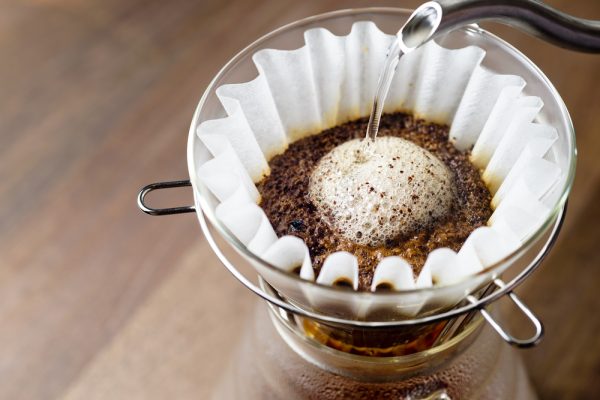When ground coffee is mixed with hot water for less than one minute before brewing there’s a release of carbon dioxide, which creates a richer flavor, and that’s the process of blooming coffee.
How It Starts
Keeping an eye on each of the steps it takes to make a mind-blowing cup of coffee is the difference between a sour-bitter cup or a delicious, rich cup. After roasting and grinding the beans, the next action would be degassing, blooming, and creating a smooth cup o’ joe.
The natural first step is a process called degassing is when fresh ground coffee beans release carbon dioxide for up to two weeks after it’s roasted. The less time between roasting and grinding will allow the most gas to be released. So, check the roasting date when possible.
This is also why cafes will grind coffee per order rather than beforehand. Hardcore coffee lovers may own a coffee bean grinder in order to have a fresher bloom and cup.
The grinding turns the large roasted beans into lots of tiny pieces, and hence there are more bean pieces giving off more carbon dioxide. This gas is slowly released for up to two weeks, and is the reason behind the delectable coffee smell and taste when brewed.
Coffee Blooming
The addition of boiled water will cause the coffee grounds to bubble and foam, which escalates the release of carbon dioxide. The finer the grind, the more water reacting with the coffee, and therefore the more release of CO2.
The lack of bubbling could mean the coffee has gone stale, and isn’t as fresh. That’s why the foaming will only be seen with fresh grounds for blooming.
Add enough piping hot water to the grinds to just cover them, and soak for about 15 to 45 seconds. Or about 2 g of water for each gram of coffee.
Check out this video for a visual of a quick pour over bloom:
Does Blooming Coffee Change The Flavor?
Blooming fresh coffee grounds compared to brewing older coffee will surely taste different from one another. The CO2 in the coffee grounds have a natural bitter taste, that’s why the boiled water increases the flavor when blooming.
Depending on the time bloomed and brewed, where the coffee is from, and how long it’s been roasted for can have an impact on the flavor as well.
Perfect Bloom Time
Depending on the beans and freshness, the time for blooming will vary, but generally blooming doesn’t take long, about 15 to 30 seconds. This process gets the coffee ready for the engulfment of hot water for brewing, or pour over.
Pour a small amount of boiling hot water over the perfect amount of coffee, about 2 g of water for every 1 g of coffee. Let sit for at least 15 to 45 seconds at most before stirring or adding more water. It’ll foam, then add the rest of the hot water to complete the amount, and strain.
There’s a lack of the blooming process in an electric coffee maker, usually because the water isn’t boiling hot, and doesn’t allow time for blooming to take place.
Blooming is achieved best with a fresh ground of coffee less than a few weeks old, and a pour over or French press method. The older the coffee, the more time should be added to the bloom -about 30 to 45 seconds.
Blooming for over 45 seconds won’t enhance the brew as much, because of the increased amount of acidity that’s released during the extraction. If a more acidic flavor is a preference, then add more water instead.
Does A Longer Steep Affect Caffeine?
Coffee bloomed and brewed in hot water for a longer amount of time may have more caffeine than that of an iced coffee or cold brew coffee. That’s because hot water releases more caffeine in the beans.
For instance, a 16-ounce cup of hot coffee has about 210 to 360 mg of caffeine, and in the same amount of iced coffee there may be about 165 mg of caffeine. In 16 oz of cold brew there could be around 205 mg.
Storage Information
Definitely pay attention to the temperature that the beans are stored at in home. The hotter the area will result in more gasses being released during the bloom. This could cause the coffee to become stale quicker.
Store in an air-tight container so that no gas escapes and no gas or air enter.
It could also be important to note that due to the excess oil on darker roasts they will release less gas being released, so that may help for longer storage.
Get With The Bloom
The difference between a cup of dense, acidic diner coffee and a cup of smooth, rich coffee that has been bloomed is astounding and a must-try. The natural science behind letting the boiling water release CO2 out of the coffee grounds by blooming for a few seconds before brewing creates delicious results. Nonetheless, here are the recommendations for blooming coffee.
The method starts after the roasted beans are ground, in which the natural degassing continues to happen for up to two weeks. This entrapment of gasses is what makes coffee smell glorious and taste bitter.
It’s also always best to go with the freshest coffee grinds in order to get a successful bloom. Blooming also works best with a French press or pour over method, because of the control of boiling water temperature and the ability to allow time for the coffee to bloom and brew.
Store the coffee in a cool, dry place, and away from light and heat in order to keep it as fresh as possible.
Avoid blooming for longer than 45 seconds, because it only makes it more acidic and less flavorful. The perfect bloom time is between 30 and 45 seconds.

